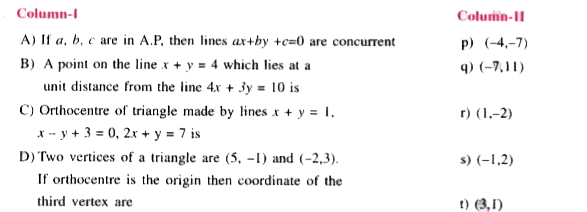Let A(0,0), B (5,0), C (5,3) and D(0,3) be the vertice of rectiangle ABCD , If P is a variable point lying inside the rectangle ABCD and d (P,L) denotes perpendicular distance of point P from line L
If (d(P,AB)−32)2+(d(P,AD))2≥1, then area of region in which P lies is (in sq.units)Solution in Telugu
15−2π
10−π2
15−π
15−π2
The correct Answer is:D
Step by step video, text & image solution for Let A(0,0), B (5,0), C (5,3) and D(0,3) be the vertice of rectiangle ABCD , If P is a variable point lying inside the rectangle ABCD and d (P,L) denotes perpendicular distance of point P from line L If (d(P,AB)-(3)/2)^2 +(d(P,AD))^2ge1, then area of region in which P lies is (in sq.units) by Maths experts to help you in doubts & scoring excellent marks in Class 11 exams.
Updated on:21/07/2023Topper's Solved these Questions
- STRAIGHT LINESBOOK - AAKASH SERIESCHAPTER - STRAIGHT LINESEXERCISE - ADDITIONAL PRACTICE EXERCISE (LEVEL-II (ADVANCED) PRACTICE SHEET (ADDVANCED)) (Integer Type Questions)
3 Videos
- REVISION EXERCISEBOOK - AAKASH SERIESCHAPTER - REVISION EXERCISEEXERCISE - PROPERTIES OF TRIANGLES
57 Videos
- TANGENT AND NORMAL BOOK - AAKASH SERIESCHAPTER - TANGENT AND NORMAL EXERCISE - ADVANCED SUBJECTIVE TYPE QUESTIONS
48 Videos
Similar Questions

View SolutionIn a triangle ABC, if A,B, C are in A.P and b:c =√3:√2, then
View SolutionFind the equations of tangent and normal to the curve
(xa)4+(yb)4=2 at (a,b)
View SolutionConsider a rectangle ABCD formed by the points A=(0,0), B= (6, 0), C =(6, 4) and D =(0,4), P (x, y) is a moving interior point of the rectangle, moving in such a way that d (P, AB)le min {d (P, BC), d (P, CD) and d (P, AD)} here d (P, AB), d (P, BC), d (P, CD) and d (P, AD) represent the distance of the point P from the sides AB, BC, CD and AD respectively. Area of the region representing all possible positions of the point P is equal to
View SolutionLet O(0.0),A(6,0) and B(3,sqrt3) be the vertices of triangle OAB. Let R those points P inside triangle OAB which satisfy d(P, OA) minimum (d(P,OB),d(P,AB) where d(P, OA), d(P, OB) and d(P, AB) represent the distance of P from the sides OA, OB and AFB respectively. If the area of region R is 9 (a -sqrtb) where a and b are coprime, then find the value of (a+ b)
View SolutionA(3, 4),B(0,0) and c(3,0) are vertices of DeltaABC. If 'P' is the point inside the DeltaABC, such that d(P, BC)le min. {d(P, AB), d (P, AC)}. Then the maximum of d (P, BC) is.(where d(P, BC) represent distance between P and BC).
View SolutionLet ABC be a triangle with vertices A-=(6,2sqrt(3)+1)) ) B-=(4,2) and C-=(8,2). Let R be the region consisting of all those points P inside Delta ABC which satisfyd (P,BC)>=max{d(P,AB);d(P,AC)}, where d(P,L) denotes the distance of the point from the line L,then
View SolutionLet d(P, OA) le min {d (P, AB), d(P, BC), d (P, OC)} where d denotes the distance from the point to the corresponding line and S be the region consisting of all those points P inside the rectangle OABC such that O = (0, 0), A = (3, 0), B = (3, 2) and C = (0, 2), which satisfy the above relation, then area of the region S is
View Solutionfind the value of p if points A(6,1),B(8,2),C(9,4)D(P,3) are vertices of a parallelogram ABCD
View SolutionLet O(0, 0) and B(1,1√3) be the vertices of a triangle. Let R be the region consisting of all those points P inside ΔOAB satisfying. d(P,OA)lr min {d(P,OB),d(P,AB)}, where d denotes the distance from the point P to the corresponding line. Let M be peak of region R.
The perimeter of region R is equal to
View SolutionLet O(0,0),A(2,0),andB(11√3) be the vertices of a triangle. Let R be the region consisting of all those points P inside OAB which satisfy d(P,OA)≤min[d(p,OB),d(P,AB)] , where d denotes the distance from the point to the corresponding line. Sketch the region R and find its area.
View SolutionLet ABCD be a rectangle and P be any point in its plane. Show that AP2+PC2=PB2+PD2.
View SolutionLet ABCD be a rectangle and P be any point in its plane. Show that AP2+PC2=PB2+PD2.
View SolutionABCD is a parallelogram. P is a point on the side BC DP when produced meets AB produced at L. Prove that DPPL=DCBL (ii) DLDP=ALDC
View SolutionConsider a ΔOAB formed by the point O(0,0),A(2,0),B(1,√3).P(x,y) is an arbitrary interior point of triangle moving in such a way that d(P,OA)+d(P,AB)+d(P,OB)=√3, where d(P,OA),d(P,AB),d(P,OB) represent the distance of P from the sides OA,AB and OB respectively
Area of region reperesenting all possible position of point P is equal to
View Solution
